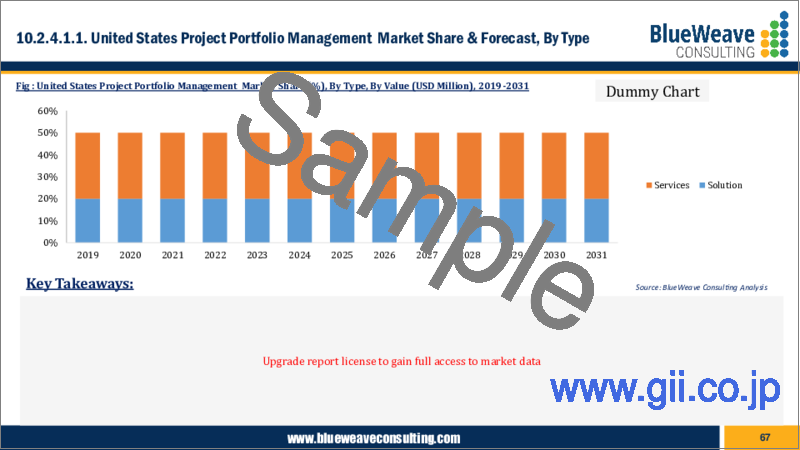|
|
市場調査レポート
商品コード
1401168
プロジェクト・ポートフォリオ・マネジメントの世界市場:市場規模、シェア、動向分析、機会、予測(2019~2029年)Project Portfolio Management Market - Global Size, Share, Trend Analysis, Opportunity and Forecast Report, 2019-2029, Segmented By Type ; By Deployment Type ; By Vertical ; By Region |
||||||
|
|||||||
| プロジェクト・ポートフォリオ・マネジメントの世界市場:市場規模、シェア、動向分析、機会、予測(2019~2029年) |
|
出版日: 2023年12月20日
発行: Blueweave Consulting
ページ情報: 英文 400 Pages
納期: 2~3営業日
|
- 全表示
- 概要
- 目次
世界のプロジェクト・ポートフォリオ・マネジメント(PPM)の市場規模は、CAGR 6.49%で拡大し、2029年には66億8,000万米ドルに達すると予測されています。
世界のプロジェクト・ポートフォリオ・マネジメント(PPM)市場は、効率的なプロジェクト管理のニーズの高まりとデジタル変革の進展により、活況を呈しています。
戦略コンサルティング・市場調査会社大手のBlueWeave Consulting社は、最近の調査で、2022年の世界のプロジェクト・ポートフォリオ・マネジメント(PPM)市場規模を45億8,000万米ドルと予測しました。2023~2029年にかけての予測期間中、世界のプロジェクト・ポートフォリオ・マネジメント(PPM)の市場規模は、CAGR 6.49%の著しい成長を遂げ、2029年には66億8,000万米ドルの規模に達するとBlueWeave社は予測しています。世界のプロジェクト・ポートフォリオ・マネジメント(PPM)市場の主な成長促進要因には、遠隔地からのタスク監督におけるクラウドベースのサービスの受け入れ拡大が含まれます。ヘルスケア、政府、BFSI、通信、エンジニアリング、建設など、さまざまな分野で自動化とデジタル化が進み、生産性と業務効率の向上を目的とした監視・分析ソリューションの需要が高まっています。この動向は、特にプロジェクト・ポートフォリオ・マネジメント(PPM)ソリューションの採用を後押ししています。プロジェクト管理の複雑化は、タイムリーで効率的な監視の必要性と相まって、予測期間中の市場拡大を促進すると予想されます。これは、プロジェクト・ポートフォリオ・マネジメント(PPM)ソリューションに対する需要の高まりによって裏付けられており、プロジェクト運営とリソース管理の包括的な360度ビューを得る必要性がその原動力となっています。PPMソフトウェアは、協調的なスケジューリングやプランニングを容易にし、意思決定プロセスを迅速化します。また、BYOD(Bring Your Own Device)の動向の高まりや、迅速な投資収益率(ROI)の達成を重視する組織の動きも、市場に影響を与えています。PPMソフトウェアは、生産性を高め、イノベーションを促進し、進化する経済情勢や競合情勢に適応する上で重要な役割を果たします。時間追跡、データ分析、コスト管理などの機能を備えたPPMソフトウェアは、多様なビジネスニーズに対応しています。ブラジル、中国、インドなどの新興経済諸国ではコネクテッドデバイスの普及が進んでおり、研究開発への投資も進んでいるため、モバイルアプリケーションベースのPPMのような革新的なソリューションが生まれ、市場の裾野が広がり、全体的な成長が促進されています。しかし、コストや実装の課題、セキュリティ上の懸念が、分析期間中の市場全体の成長を抑制すると予想されます。
機会 - カスタマイズと統合
技術の進歩と消費者行動の変化を特徴とする、急速に進化するビジネス情勢において、組織は競争力を維持するために迅速に適応しなければならないです。従来のプロジェクト管理手法は、このようなダイナミックな環境では、リアルタイムの調整能力に欠け、しばしば失敗します。プロジェクト・ポートフォリオ・マネジメント(PPM)の採用は、カスタマイズと統合のための戦略的必須条件となります。進行中のプロジェクトの概要をリアルタイムで把握できるPPMは、俊敏な意思決定を促進します。管理者は、タスクの優先順位付け、リソースの再配分、焦点の転換を容易に行うことができ、新たな課題に効果的に対処したり、新たな機会を捉えたりすることができます。このことは、変化し続けるビジネス環境に組織戦略をシームレスに適合させるために、PPMフレームワークにおけるカスタマイズと統合が重要な役割を果たすことを強調しています。
COVID-19が世界のプロジェクト・ポートフォリオ・マネジメント(PPM)市場に与える影響
COVID-19の大流行は、世界のプロジェクト・ポートフォリオ・マネジメント(PPM)市場に悪影響を与えました。ウイルスの急速な蔓延に対応するため、世界各国の政府は、社会的距離と自己隔離対策を実施するため、現場の人員を削減することを目的とした労働政策を含む厳しい対策を実施し、それによってウイルスの感染を抑制しました。このような対策は、企業組織やプロジェクトマネジャーにとって課題となり、従来のプロジェクト管理手法では、進行中のプロジェクトを監視したり、新規プロジェクトやリソースを割り当てたりすることができなかった。その結果、企業はプロジェクト・ポートフォリオ・マネジメントソリューションを採用し、パンデミックによる混乱を考慮した効果的なプロジェクト計画と実行を可能にする専門ツールを活用しました。
世界のプロジェクト・ポートフォリオ・マネジメント(PPM)市場 - 業界別
プロジェクト・ポートフォリオ・マネジメント(PPM)の世界市場は、業種別にIT・通信、ヘルスケア・ライフサイエンス、製造、建設、小売・消費財、BFSIに分類されます。プロジェクト・ポートフォリオ・マネジメント(PPM)の世界市場において、業界別ではBFSIセグメントが最も高いシェアを占めています。PPMソリューションは、特に複雑な複数地域の顧客取引データの処理において、BFSI業界をサポートする上で極めて重要な役割を果たしています。モバイル・バンキングやeバンキングの普及に代表されるBFSIセクター内の技術進歩が、プロジェクト・ポートフォリオ・マネジメントソリューションの採用に拍車をかけています。さらに、銀行がデビット、クレジット、集中資金管理システムなどのサービスをますます活用するようになるにつれて、これらのソリューションはデータベースの監視に欠かせないものとなっています。取引情報や顧客情報の監視を容易にすることで、これらのソリューションは銀行業界の透明性向上に貢献しています。
プロジェクト・ポートフォリオ・マネジメント(PPM)の世界市場 - 地域別
プロジェクト・ポートフォリオ・マネジメント(PPM)の世界市場に関する詳細な調査レポートは、主要5地域の様々な国別市場をカバーしています:北米、欧州、アジア太平洋、ラテンアメリカ、中東アフリカです。北米は世界のプロジェクト・ポートフォリオ・マネジメント(PPM)市場で最も高いシェアを占めています。この地域の優位性は、継続的なインフラ整備と新興企業の台頭によるものです。この地域の業界情勢は、ビジネスインテリジェンスとアナリティクスソリューションの広範な採用を示しており、市場成長の推進に極めて重要な役割を果たしています。さらに、強固なデジタルインフラを持つ企業は、協調的な意思決定のためにPPMソリューションを活用し、プロジェクトの成功率を高めています。米国では、ヘルスケア、製造業、BFSI、建設業など多様なセクターがPPMサービスを採用し、事業運営を最適化して不要なコストを削減しています。このような環境が市場拡大を後押しし、業界各社はサービスの提供や顧客ポートフォリオを拡大するためにM&Aなどの戦略を採用しています。
競合情勢
世界のプロジェクト・ポートフォリオ・マネジメント(PPM)市場で事業を展開する主要企業には、Oracle Corporation、ServiceNow Inc.、Microsoft Corporation、Atlassian Corporation Plc、Asana Inc.、SAP SE、Wrike(Citrix Systems Inc.)、Workday Inc.、Planview Inc.(Changepoint)、Smartsheet Inc.、Upland Software Inc.などがあります。市場シェアをさらに高めるために、これらの企業はM&A、パートナーシップ、ジョイントベンチャー、ライセンス契約、新製品の発売など、さまざまな戦略を採用しています。
本レポートの詳細な分析により、世界のプロジェクト・ポートフォリオ・マネジメント(PPM)市場の成長可能性、今後の動向、統計に関する情報を提供します。また、総市場規模の予測を促進する要因も取り上げています。当レポートは、世界のプロジェクト・ポートフォリオ・マネジメント(PPM)市場の最近の技術動向や、意思決定者が健全な戦略的意思決定を行うための業界洞察を提供することをお約束します。さらに、市場の成長促進要因・課題・競争力についても分析しています。
目次
第1章 調査の枠組み
第2章 エグゼクティブサマリー
第3章 世界のプロジェクト・ポートフォリオ・マネジメント(PPM)市場の洞察
- 業界のバリューチェーン分析
- DROC分析
- 成長促進要因
- 効率的なプロジェクト管理のニーズの高まり
- デジタルトランスフォーメーション
- 抑制要因
- コスト・導入の課題
- セキュリティ上の懸念
- 機会
- 市場拡大
- カスタマイズ・統合
- 課題
- 競合
- 市場動向への適応
- 成長促進要因
- 技術の進歩/最近の開発
- 規制の枠組み
- ポーターのファイブフォース分析
第4章 世界のプロジェクト・ポートフォリオ・マネジメント(PPM)市場概要
- 市場規模と予測、2019~2029年
- 金額別
- 市場シェアと予測
- タイプ別
- ソリューション
- サービス
- 展開タイプ別
- クラウド
- オンプレミス
- 業界別
- IT・通信
- ヘルスケア・ライフサイエンス
- 製造
- 建設
- 小売・消費財
- BFSI
- その他
- 地域別
- 北米
- 欧州
- アジア太平洋(APAC)
- ラテンアメリカ(LATAM)
- 中東・アフリカ(MEA)
- タイプ別
第5章 北米のプロジェクト・ポートフォリオ・マネジメント(PPM)市場
- 市場規模と予測、2019~2029年
- 金額別
- 市場シェアと予測
- タイプ別
- 展開タイプ別
- 業界別
- 国別
- 米国
- カナダ
第6章 欧州のプロジェクト・ポートフォリオ・マネジメント(PPM)市場
- 市場規模と予測、2019~2029年
- 金額別
- 市場シェアと予測
- タイプ別
- 展開タイプ別
- 業界別
- 国別
- ドイツ
- 英国
- イタリア
- フランス
- スペイン
- ベルギー
- ロシア
- オランダ
- その他の欧州
第7章 アジア太平洋のプロジェクト・ポートフォリオ・マネジメント(PPM)市場
- 市場規模と予測、2019~2029年
- 金額別
- 市場シェアと予測
- タイプ別
- 展開タイプ別
- 業界別
- 国別
- 中国
- インド
- 日本
- 韓国
- オーストラリア・ニュージーランド
- インドネシア
- マレーシア
- シンガポール
- ベトナム
- その他のアジア太平洋
第8章 ラテンアメリカのプロジェクト・ポートフォリオ・マネジメント(PPM)市場
- 市場規模と予測、2019~2029年
- 金額別
- 市場シェアと予測
- タイプ別
- 展開タイプ別
- 業界別
- 国別
- ブラジル
- メキシコ
- アルゼンチン
- ペルー
- その他のラテンアメリカ
第9章 中東・アフリカのプロジェクト・ポートフォリオ・マネジメント(PPM)市場
- 市場規模と予測、2019~2029年
- 金額別
- 市場シェアと予測
- タイプ別
- 展開タイプ別
- 業界別
- 国別
- サウジアラビア
- アラブ首長国連邦
- カタール
- クウェート
- 南アフリカ
- ナイジェリア
- アルジェリア
- その他の中東・アフリカ
第10章 競合情勢
- 主要企業とその製品リスト
- 世界のプロジェクト・ポートフォリオ・マネジメント(PPM)市場シェア分析、2022年
- 経営パラメータによる競合ベンチマーキング
- 主要な戦略的展開(合併、買収、パートナーシップなど)
第11章 世界のプロジェクト・ポートフォリオ・マネジメント(PPM)市場に対するCOVID-19症の影響
第12章 企業プロファイル
- Oracle Corporation
- ServiceNow Inc.
- Microsoft Corporation
- Atlassian Corporation Plc
- Asana Inc.
- SAP SE
- Wrike(Citrix Systems Inc.)
- Workday Inc.
- Planview Inc.(changepoint)
- Smartsheet Inc.
- Upland Software Inc.
- その他の主要企業
第13章 主要な戦略的推奨事項
第14章 調査手法
Global Project Portfolio Management (PPM) Market Size Expands at Significant CAGR of 6.49% to Touch USD 6.68 Billion by 2029
Global Project Portfolio Management (PPM) Market is flourishing because of an increasing need for efficient project management and growing digital transformation.
BlueWeave Consulting, a leading strategic consulting and market research firm, in its recent study, estimated the Global Project Portfolio Management (PPM) Market size at USD 4.58 billion in 2022. During the forecast period between 2023 and 2029, BlueWeave expects Global Project Portfolio Management (PPM) Market size to grow at a significant CAGR of 6.49% reaching a value of USD 6.68 billion by 2029. Major growth drivers for the Global Project Portfolio Management (PPM) Market include an increasing acceptance of cloud-based services in overseeing tasks remotely. The rise in automation and digitalization activities across various sectors such as healthcare, government, BFSI, telecom, and engineering and construction has generated a demand for monitoring and analytical solutions, aiming to enhance productivity and operational efficiency. This trend notably supports the adoption of project portfolio management (PPM) solutions. The escalating intricacies in project management, coupled with the imperative for timely and efficient oversight, are expected to propel market expansion during the forecast period. It is underscored by the growing demand for Project Portfolio Management (PPM) solutions, driven by the necessity to obtain a comprehensive 360-degree view of project operations and resource management. PPM software facilitates collaborative scheduling, planning, and expedites decision-making processes. Also, the market is influenced by the rising trend of Bring Your Own Device (BYOD) and organizations' intensified focus on achieving swift Return on Investment (ROI). PPM software proves instrumental in enhancing productivity, fostering innovation, and adapting to evolving economic landscapes and competitive dynamics. With features like time tracking, data analytics, and cost management, PPM software addresses diverse business needs. The industry's positive trajectory is reinforced by the increasing prevalence of connected devices in emerging economies like Brazil, China, and India, as well as ongoing investments in research and development, fostering the creation of innovative solutions such as mobile application-based PPM, thereby expanding market reach and driving overall growth. However, costs and implementation challenges and security concerns are anticipated to restrain the overall market growth during the period in analysis.
Opportunity - Customization and integration
In the swiftly evolving business landscape, characterized by technological advancements and changes in consumer behavior, organizations must rapidly adapt to stay competitive. Conventional project management methods often fall short in this dynamic setting, lacking the capacity for real-time adjustments. The adoption of Project Portfolio Management (PPM) becomes a strategic imperative for customization and integration. By offering a real-time overview of ongoing projects, PPM facilitates agile decision-making. Managers can easily prioritize tasks, reallocate resources, and shift focus to effectively address new challenges or seize emerging opportunities. This underscores the vital role of customization and integration within the PPM framework to seamlessly align organizational strategies with the ever-changing business environment.
Impact of COVID-19 on Global Project Portfolio Management (PPM) Market
COVID-19 pandemic adversely affected the Global Project Portfolio Management (PPM) Market. In response to the rapid spread of the virus, governments worldwide implemented stringent measures, including workforce policies aimed at reducing on-site personnel to enforce social distancing and self-isolation measures, thereby curbing the virus's transmission. These measures presented challenges for business organizations and project managers, impeding their ability to monitor ongoing projects and allocate new projects and resources through conventional project management approaches. Consequently, organizations adopted project portfolio management solutions, utilizing specialized tools to enable effective project planning and execution in light of the disruptions caused by the pandemic.
Global Project Portfolio Management (PPM) Market - By Vertical
Based on vertical, the Global Project Portfolio Management (PPM) Market is divided into IT & Telecom, Healthcare & Lifesciences, Manufacturing, Construction, Retail & Consumer Goods, and BFSI segments. The BFSI segment holds the highest share in the Global Project Portfolio Management (PPM) Market by vertical. PPM solutions play a pivotal role in supporting the BFSI industry, particularly in handling complex multi-regional customer transaction data. The technological advancements within the BFSI sector, exemplified by the prevalence of mobile banking and e-banking, have spurred the adoption of project portfolio management solutions. Additionally, as banks increasingly utilize services like debit, credit, and centralized fund management systems, these solutions become instrumental in monitoring databases. By facilitating the oversight of transactional and customer information, these solutions contribute to enhancing transparency within the sector.
Global Project Portfolio Management (PPM) Market - By Region
The in-depth research report on the Global Project Portfolio Management (PPM) Market covers various country-specific markets across five major regions: North America, Europe, Asia Pacific, Latin America, and Middle East and Africa. North America holds the highest share in the Global Project Portfolio Management (PPM) Market. The region's dominance is attributed to ongoing infrastructure developments and the rise of startups. The region's industrial landscape witnesses the widespread adoption of business intelligence and analytics solutions, playing a pivotal role in propelling market growth. Furthermore, entities with robust digital infrastructure leverage PPM solutions for collaborative decision-making, elevating project success rates. In the United States, diverse sectors like healthcare, manufacturing, BFSI, and construction embrace PPM services, optimizing business operations and reducing unnecessary costs. This conducive environment fuels market expansion, prompting industry players to employ strategies like mergers and acquisitions to augment service offerings and client portfolios.
Competitive Landscape
Major players operating in the Global Project Portfolio Management (PPM) Market include Oracle Corporation, ServiceNow Inc., Microsoft Corporation, Atlassian Corporation Plc, Asana Inc., SAP SE, Wrike (Citrix Systems Inc.), Workday Inc., Planview Inc. (Changepoint), Smartsheet Inc., and Upland Software Inc. To further enhance their market share, these companies employ various strategies, including mergers and acquisitions, partnerships, joint ventures, license agreements, and new product launches.
The in-depth analysis of the report provides information about growth potential, upcoming trends, and statistics of Global Project Portfolio Management (PPM) Market. It also highlights the factors driving forecasts of total market size. The report promises to provide recent technology trends in Global Project Portfolio Management (PPM) Market and industry insights to help decision-makers make sound strategic decisions. Furthermore, the report also analyzes the growth drivers, challenges, and competitive dynamics of the market.
Table of Contents
1. Research Framework
- 1.1. Research Objective
- 1.2. Product Overview
- 1.3. Market Segmentation
2. Executive Summary
3. Global Project Portfolio Management (PPM) Market Insights
- 3.1. Industry Value Chain Analysis
- 3.2. DROC Analysis
- 3.2.1. Growth Drivers
- 3.2.1.1. Increased need for efficient project management
- 3.2.1.2. Digital transformation
- 3.2.2. Restraints
- 3.2.2.1. Costs and implementation challenges
- 3.2.2.2. Security concerns
- 3.2.3. Opportunities
- 3.2.3.1. Market expansion
- 3.2.3.2. Customization and integration
- 3.2.4. Challenges
- 3.2.4.1. Competition
- 3.2.4.2. Adaptation to market trends
- 3.2.1. Growth Drivers
- 3.3. Technological Advancements/Recent Developments
- 3.4. Regulatory Framework
- 3.5. Porter's Five Forces Analysis
- 3.5.1. Bargaining Power of Suppliers
- 3.5.2. Bargaining Power of Buyers
- 3.5.3. Threat of New Entrants
- 3.5.4. Threat of Substitutes
- 3.5.5. Intensity of Rivalry
4. Global Project Portfolio Management (PPM) Market Overview
- 4.1. Market Size & Forecast, 2019-2029
- 4.1.1. By Value (USD Billion)
- 4.2. Market Share and Forecast
- 4.2.1. By Type
- 4.2.1.1. Solution
- 4.2.1.2. Services
- 4.2.2. By Deployment Type
- 4.2.2.1. Cloud
- 4.2.2.2. On-premises
- 4.2.3. By Vertical
- 4.2.3.1. IT & Telecom
- 4.2.3.2. Healthcare & Lifesciences
- 4.2.3.3. Manufacturing
- 4.2.3.4. Construction
- 4.2.3.5. Retail & Consumer Goods
- 4.2.3.6. BFSI
- 4.2.3.7. Others
- 4.2.4. By Region
- 4.2.4.1. North America
- 4.2.4.2. Europe
- 4.2.4.3. Asia Pacific (APAC)
- 4.2.4.4. Latin America (LATAM)
- 4.2.4.5. Middle East and Africa (MEA)
- 4.2.1. By Type
5. North America Project Portfolio Management (PPM) Market
- 5.1. Market Size & Forecast, 2019-2029
- 5.1.1. By Value (USD Billion)
- 5.2. Market Share & Forecast
- 5.2.1. By Type
- 5.2.2. By Deployment Type
- 5.2.3. By Vertical
- 5.2.4. By Country
- 5.2.4.1. United States
- 5.2.4.1.1. By Type
- 5.2.4.1.2. By Deployment Type
- 5.2.4.1.3. By Vertical
- 5.2.4.2. Canada
- 5.2.4.2.1. By Type
- 5.2.4.2.2. By Deployment Type
- 5.2.4.2.3. By Vertical
6. Europe Project Portfolio Management (PPM) Market
- 6.1. Market Size & Forecast, 2019-2029
- 6.1.1. By Value (USD Billion)
- 6.2. Market Share & Forecast
- 6.2.1. By Type
- 6.2.2. By Deployment Type
- 6.2.3. By Vertical
- 6.2.4. By Country
- 6.2.4.1. Germany
- 6.2.4.1.1. By Type
- 6.2.4.1.2. By Deployment Type
- 6.2.4.1.3. By Vertical
- 6.2.4.2. United Kingdom
- 6.2.4.2.1. By Type
- 6.2.4.2.2. By Deployment Type
- 6.2.4.2.3. By Vertical
- 6.2.4.3. Italy
- 6.2.4.3.1. By Type
- 6.2.4.3.2. By Deployment Type
- 6.2.4.3.3. By Vertical
- 6.2.4.4. France
- 6.2.4.4.1. By Type
- 6.2.4.4.2. By Deployment Type
- 6.2.4.4.3. By Vertical
- 6.2.4.5. Spain
- 6.2.4.5.1. By Type
- 6.2.4.5.2. By Deployment Type
- 6.2.4.5.3. By Vertical
- 6.2.4.6. Belgium
- 6.2.4.6.1. By Type
- 6.2.4.6.2. By Deployment Type
- 6.2.4.6.3. By Vertical
- 6.2.4.7. Russia
- 6.2.4.7.1. By Type
- 6.2.4.7.2. By Deployment Type
- 6.2.4.7.3. By Vertical
- 6.2.4.8. The Netherlands
- 6.2.4.8.1. By Type
- 6.2.4.8.2. By Deployment Type
- 6.2.4.8.3. By Vertical
- 6.2.4.9. Rest of Europe
- 6.2.4.9.1. By Type
- 6.2.4.9.2. By Deployment Type
- 6.2.4.9.3. By Vertical
7. Asia Pacific Project Portfolio Management (PPM) Market
- 7.1. Market Size & Forecast, 2019-2029
- 7.1.1. By Value (USD Billion)
- 7.2. Market Share & Forecast
- 7.2.1. By Type
- 7.2.2. By Deployment Type
- 7.2.3. By Vertical
- 7.2.4. By Country
- 7.2.4.1. China
- 7.2.4.1.1. By Type
- 7.2.4.1.2. By Deployment Type
- 7.2.4.1.3. By Vertical
- 7.2.4.2. India
- 7.2.4.2.1. By Type
- 7.2.4.2.2. By Deployment Type
- 7.2.4.2.3. By Vertical
- 7.2.4.3. Japan
- 7.2.4.3.1. By Type
- 7.2.4.3.2. By Deployment Type
- 7.2.4.3.3. By Vertical
- 7.2.4.4. South Korea
- 7.2.4.4.1. By Type
- 7.2.4.4.2. By Deployment Type
- 7.2.4.4.3. By Vertical
- 7.2.4.5. Australia & New Zealand
- 7.2.4.5.1. By Type
- 7.2.4.5.2. By Deployment Type
- 7.2.4.5.3. By Vertical
- 7.2.4.6. Indonesia
- 7.2.4.6.1. By Type
- 7.2.4.6.2. By Deployment Type
- 7.2.4.6.3. By Vertical
- 7.2.4.7. Malaysia
- 7.2.4.7.1. By Type
- 7.2.4.7.2. By Deployment Type
- 7.2.4.7.3. By Vertical
- 7.2.4.8. Singapore
- 7.2.4.8.1. By Type
- 7.2.4.8.2. By Deployment Type
- 7.2.4.8.3. By Vertical
- 7.2.4.9. Vietnam
- 7.2.4.9.1. By Type
- 7.2.4.9.2. By Deployment Type
- 7.2.4.9.3. By Vertical
- 7.2.4.10. Rest of APAC
- 7.2.4.10.1. By Type
- 7.2.4.10.2. By Deployment Type
- 7.2.4.10.3. By Vertical
8. Latin America Project Portfolio Management (PPM) Market
- 8.1. Market Size & Forecast, 2019-2029
- 8.1.1. By Value (USD Billion)
- 8.2. Market Share & Forecast
- 8.2.1. By Type
- 8.2.2. By Deployment Type
- 8.2.3. By Vertical
- 8.2.4. By Country
- 8.2.4.1. Brazil
- 8.2.4.1.1. By Type
- 8.2.4.1.2. By Deployment Type
- 8.2.4.1.3. By Vertical
- 8.2.4.2. Mexico
- 8.2.4.2.1. By Type
- 8.2.4.2.2. By Deployment Type
- 8.2.4.2.3. By Vertical
- 8.2.4.3. Argentina
- 8.2.4.3.1. By Type
- 8.2.4.3.2. By Deployment Type
- 8.2.4.3.3. By Vertical
- 8.2.4.4. Peru
- 8.2.4.4.1. By Type
- 8.2.4.4.2. By Deployment Type
- 8.2.4.4.3. By Vertical
- 8.2.4.5. Rest of LATAM
- 8.2.4.5.1. By Type
- 8.2.4.5.2. By Deployment Type
- 8.2.4.5.3. By Vertical
9. Middle East & Africa Project Portfolio Management (PPM) Market
- 9.1. Market Size & Forecast, 2019-2029
- 9.1.1. By Value (USD Billion)
- 9.2. Market Share & Forecast
- 9.2.1. By Type
- 9.2.2. By Deployment Type
- 9.2.3. By Vertical
- 9.2.4. By Country
- 9.2.4.1. Saudi Arabia
- 9.2.4.1.1. By Type
- 9.2.4.1.2. By Deployment Type
- 9.2.4.1.3. By Vertical
- 9.2.4.2. UAE
- 9.2.4.2.1. By Type
- 9.2.4.2.2. By Deployment Type
- 9.2.4.2.3. By Vertical
- 9.2.4.3. Qatar
- 9.2.4.3.1. By Type
- 9.2.4.3.2. By Deployment Type
- 9.2.4.3.3. By Vertical
- 9.2.4.4. Kuwait
- 9.2.4.4.1. By Type
- 9.2.4.4.2. By Deployment Type
- 9.2.4.4.3. By Vertical
- 9.2.4.5. South Africa
- 9.2.4.5.1. By Type
- 9.2.4.5.2. By Deployment Type
- 9.2.4.5.3. By Vertical
- 9.2.4.6. Nigeria
- 9.2.4.6.1. By Type
- 9.2.4.6.2. By Deployment Type
- 9.2.4.6.3. By Vertical
- 9.2.4.7. Algeria
- 9.2.4.7.1. By Type
- 9.2.4.7.2. By Deployment Type
- 9.2.4.7.3. By Vertical
- 9.2.4.8. Rest of MEA
- 9.2.4.8.1. By Type
- 9.2.4.8.2. By Deployment Type
- 9.2.4.8.3. By Vertical
10. Competitive Landscape
- 10.1. List of Key Players and Their Offerings
- 10.2. Global Project Portfolio Management (PPM) Market Share Analysis, 2022
- 10.3. Competitive Benchmarking, By Operating Parameters
- 10.4. Key Strategic Developments (Mergers, Acquisitions, Partnerships, etc.)
11. Impact of Covid-19 on Global Project Portfolio Management (PPM) Market
12. Company Profile (Company Overview, Financial Matrix, Competitive Landscape, Key Personnel, Key Competitors, Contact Address, Strategic Outlook, SWOT Analysis)
- 12.1. Oracle Corporation
- 12.2. ServiceNow Inc.
- 12.3. Microsoft Corporation
- 12.4. Atlassian Corporation Plc
- 12.5. Asana Inc.
- 12.6. SAP SE
- 12.7. Wrike (Citrix Systems Inc.)
- 12.8. Workday Inc.
- 12.9. Planview Inc. (changepoint)
- 12.10. Smartsheet Inc.
- 12.11. Upland Software Inc.
- 12.12. Other Prominent Players
13. Key Strategic Recommendations
14. Research Methodology
- 14.1. Qualitative Research
- 14.1.1. Primary & Secondary Research
- 14.2. Quantitative Research
- 14.3. Market Breakdown & Data Triangulation
- 14.3.1. Secondary Research
- 14.3.2. Primary Research
- 14.4. Breakdown of Primary Research Respondents, By Region
- 14.5. Assumptions & Limitations





